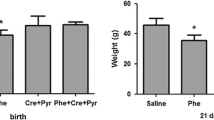Abstract
In attempting to determine the effects of mildly elevated maternal phenylalanine (Phe) blood levels on the developing fetal rat brain, a dietary supplement of Phe was given, under taste cover of Aspartame. Phe and tyrosine (Tyr) levels were mildly elevated throughout pregnancy without evidence of malnutrition. Mild hyperphenylalaninaemia with concurrent hypertyrosinaemia induced in rats prior to conception resulted in microcephaly and lasting behavioural problems in the offspring, specifically hyperactivity and learning difficulties. Dams fed Tyr to produce Tyr levels equivalent to the Phe-fed animals showed only the learning difficulties among the offspring.
α-Methyl Phe, a Phe hydroxylase inhibitor, fed in conjunction with Phe, at the level relevant to these experiments, resulted in raised Tyr levels and does not provide a better method of determining whether mildly elevated maternal Phe levels alone, or Phe and Tyr in combination, cause the abnormality found in the offspring of Phe-supplemented dams.
Therapeutic addition of Tyr to diets of mothers with even mild hyperphenylalaninaemia should be approached with caution as mild co-elevation of Phe and Tyr in the fetus may be harmful.
In the face of such a possible therapeutic dilemma alternatives, such as dietary additions of other essential amino acids to limit fetal brain damage, need to be explored.
Similar content being viewed by others
References
Anderson, V.E. and Guroff, G. Enduring behavioural changes in rats with experimental phenylketonuria.Proc. Natl. Acad. Sci. USA 69 (1972) 863–867
Anderson, V. E. and Siegel, F. S. Behavioural and biochemical correlates of diet change in phenylketonuria.Pediatr. Res. 10 (1976) 10–17
Cloninger, M. R. and Baldwin, R. E. Aspartylphenylalanine methyl ester: A low calorie sweetner.Science 170 (1970) 81–82
Delvalle, J. A., Dienel, G. and Greengard, O. Comparison of α-methylphenylalanine andp-chlorophenylalanine as inducers of chronic hyperphenylalaninaemia in developing rats.Biochem. J. 170 (1978) 449–459
Delvalle, J. A. and Greengard, O. Phenylalanine hydroxlase and tyrosine aminotransferase in human fetal and adult liver.Pediatr. Res. 11 (1977) 2
Duncan, D. B.t-Tests and intervals for comparisons suggested by the data.Biometrics 31 (1975) 339–359
Fujimoto, A., Crawford, R. and Bessman, S. P. Relative inability of mother and child to convert phenylalanine to tyrosine.Biochem. Med. 21 (1979) 271–276
Kelly, C. J. and Johnson, T. C. Effects ofp-chlorophenylalanine and α-methylphenylalanine on amino acid uptake and protein synthesis in mouse neuroblastoma cells.Biochem. J. 174 (1978) 931–938
Kimble, D. P. The effects of bilateral hippocampal lesions in rats.J. Comp. Physiol. Psychol. 56 (1963) 273–283
Lenke, R. R. and Levy, L. L. Maternal phenylketonuria and hyperphenylalaninaemia: An international survey of the outcome of untreated and treated pregnancies.N. Engl. J. Med. 303 (1980) 1201–1208
Levy, H. L. and Waisbren, S. E. Effects of untreated maternal phenylketonuria and hyperphenylalaninaemia on the fetus.N. Engl. J. Med. 309 (1983) 1269–1274
McKean, C. M., Boggs, D. E. and Peterson, N. A. The influence of high phenylalanine and tyrosine on the concentrations of essential amino acids in the brain.J. Neurochem. 15 (1968) 235–324
Rice, D. N., Houston, I. B., Lyon, I. C. T., MacArthur, B. A., Mullins, P. R., Veale, A. M. O. and Guthrie, R. Transient neonatal tyrosinaemia in neonatal screening.Exerpta Medica Int. Congr. Series 606 (1983) 306–310
G. D. Searle & Co. Toxicology Report, Evansville, Il, USA (1972)
Wang, H. L. and Waisman, H. A. Experimental phenylketonuria in rats.Proc. Soc. Exp. Biol. Med. 108 (1961) 332–335
Author information
Authors and Affiliations
Rights and permissions
About this article
Cite this article
Lewis, S.A., Lyon, I.C.T. & Elliott, R.B. Outcome of pregnancy in the rat with mild hyperphenylalaninaemia and hypertyrosinaemia: Implications for the management of “human maternal PKU”. J Inherit Metab Dis 8, 113–117 (1985). https://doi.org/10.1007/BF01819292
Received:
Accepted:
Issue Date:
DOI: https://doi.org/10.1007/BF01819292




